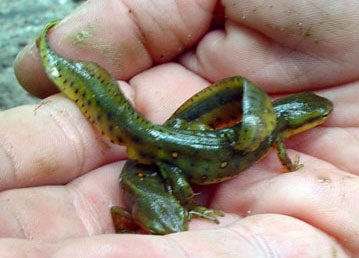SCIENTIFIC NAME:
Notophthalmus viridescens spp.
OTHER NAMES:
Eastern newt, Central newt, red-spotted newt
STATUS:
Fairly common statewide in all regions. Includes subspecies N.v. viridescens (red-spotted newt), N.v. louisianensis(central newt), and intergrades. Larvae and adults are aquatic, and juveniles (efts) are terrestrial. Lowest Conservation Concern.
DESCRIPTION:
There are two subspecies of Eastern newt in Alabama. Both species are 2.5 – 5.5 inches in length. Aquatic adult red-spotted newts are some shade of olive or green, with up to 21 red spots, outlined in black, along each side of the back. Central newts are the same color, but usually lacking the red spots. Intergrades do occur in much of central Alabama. The belly for both varieties is yellow. The land-dwelling eft stage is an intermediate terrestrial form between the larval and adult phase of development. They are usually red/orange, with rough skin, and inhabit moist woodlands. The eft stage seems less abundant in the southern portion of their range, possibly due to more harsh summer conditions.
DISTRIBUTION:
They inhabit the entire eastern United States and portions of Canada. They are found statewide in Alabama.
HABITAT:
Adults make their home in woodland ponds, ditches, and quiet portions of streams and creeks. The eft stage can be found in any woodland habitat, from bottomlands to uplands.
FEEDING HABITS:
Eastern newts forage along the bottom of streams and pools in search of aquatic crustaceans, worms, insects, and eggs.
LIFE HISTORY AND ECOLOGY:
Eastern newts have a very unique life history, beginning life as an aquatic larva with gills. An intermediate terrestrial form, called an eft, often develops and inhabits woodlands, seeking refuge under rocks, logs, and leaf litter. They can sometimes be found along the forest floor after heavy summer rain. The adults are aquatic, yet lack gills. Breeding occurs in late winter to early spring in calm water. The male courts the female until she deposits her eggs on submerged debris.
REFERENCES:
Conant, Roger. 1975. A Field Guide to Reptiles and Amphibians of Eastern and Central North America. Houghton Mifflin Co., Boston, MA. 442-443 pp.
Mount, Robert H. 1996. The Reptiles & Amphibians of Alabama. The University of Alabama Press. Tuscaloosa, AL. 144-145 pp.
AUTHOR: Matt Brock, Wildlife Biologist, Alabama Division of Wildlife and Freshwater Fisheries






